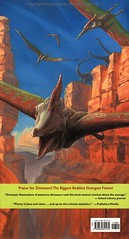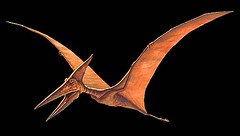 Pteranodon "Toothless Wing" was a 7m large and graceful pterosaur that would have used rising air currents, or 'thermals' to soar into the air. Pteranodon was designed to live in the air and would have been ungainly and awkward on land, putting it at risk from predators. For this reason, it probably only landed to mate, nest or rest.
Pteranodon "Toothless Wing" was a 7m large and graceful pterosaur that would have used rising air currents, or 'thermals' to soar into the air. Pteranodon was designed to live in the air and would have been ungainly and awkward on land, putting it at risk from predators. For this reason, it probably only landed to mate, nest or rest.Pteranodon was primarily a fish-eater and would have spent much of its time circling estuaries, lakes and seas. When it attacked, it swooped down towards the water's surface, dipped its beak in and grabbed a fish before swallowing it whole.
The distinctive head crest on Pteranodon was actually only found on the males and was probably used during mating displays or to intimidate male rivals. Pteranodon would have laid eggs and made nests much as many modern sea birds do. They would also have needed to provide food for their hatchlings, flying out to sea to catch fish and then bringing them back to the nest.
When in flight, an adult Pteranodon would have had few enemies. But the same would not have been true on land, where its lack of mobility would have made it vulnerable to the attentions of predators and rivals.
Being a specialised fish hunter, any injury to Pteranodon, especially on its delicate wings, would have presented a serious threat to its well-being. Any Pteranodon that found itself unable to take-off would be doomed to either starve to death or to be caught and eaten by a predator such as Giganotosaurus.
 The Evidence
The Evidence
 The Evidence
The EvidencePteranodon had a massive wingspan of eight metres. But its body weight would have been very low indeed, perhaps around 20 kg. This would have allowed it to glide for hours at a time, covering vast distances whilst expending only a minimal amount of energy. In North America, Pteranodon fossils have been discovered in rocks which would have been deposited many kilometres out to sea indicating their travelling ability. The beak of Pteranodon was toothless and was probably used to catch fish from near the surface of the ocean, perhaps scooping them out of the sea and swallowing them whole as a modern pelican does. In order to hunt effectively, Pteranodon had evolved good eyesight and a reasonably large brain.
The first Pteranodon skeleton was discovered in Kansas in 1876 and was later studied and named by palaeontologist Othniel C. Marsh. Since then, hundreds of Pteranodon skeletons have been discovered from locations across the world. There is still a debate between scientists as to which exact physical characteristics define Pteranodon.
The first Pteranodon skeleton was discovered in Kansas in 1876 and was later studied and named by palaeontologist Othniel C. Marsh. Since then, hundreds of Pteranodon skeletons have been discovered from locations across the world. There is still a debate between scientists as to which exact physical characteristics define Pteranodon.
One of the greatest mysteries about Pteranodon is the function of its large head crest. Many theories have been put forward as to the purpose of this crest. One proposes that it may have used it as a rudder or as a means of slowing the animal down. However, tests using Pteranodon models in wind tunnels suggest that to use the crest in this manner would have put undue stress on the neck.
Instead, there is now evidence that juvenile and female Pteranodon had much smaller crests than the males. This suggests that the real purpose of the crest was sexual and that it was probably used by male Pteranodon to try and impress females of the species.

No hay comentarios.:
Publicar un comentario
¡Comenta ya!
Send your Owler or Howler!
***
Si no quieres responder con tu cuenta google o wordpress o etc, puedes escoger poner tu nombre con la opción Nombre/URL.